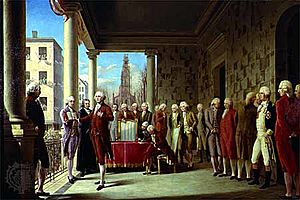Federalist Era facts for kids
| 1788–1800 | |

Washington's first inauguration
|
|
| Preceded by | Confederation period |
|---|---|
| Followed by | Jeffersonian Era |
| Leader(s) | George Washington John Adams Alexander Hamilton John Jay |
The Federalist Era was an important time in American history. It lasted from 1788 to 1800. During these years, the Federalist Party and its ideas were very powerful in American politics. Federalists usually controlled the U.S. Congress. They also had the support of President George Washington and President John Adams.
This era saw the creation of a new, stronger national government. This government was based on the U.S. Constitution. People felt more proud to be Americans, a feeling called nationalism. They also worried less about a central government becoming too powerful. The Federalist Era began when the U.S. Constitution was approved by the states. It ended when the Democratic-Republican Party won the elections in 1800.
Contents
Building a New Government
Before the Federalist Era, in the 1780s, America was called the "Confederation Period". The country was run under the Articles of Confederation. This was a very loose agreement between the states. It meant the national government was not very strong.
In 1787, leaders from most states met in Philadelphia. This meeting was called the Philadelphia Convention. They wrote a new constitution. This new plan would create a much stronger national government.
Federalists vs. Anti-Federalists
After the convention, the new constitution needed to be approved by the states.
- People who supported the new constitution were called Federalists.
- Those who were against it were called Anti-Federalists.
The Federalists won the debate in almost all states. So, the new constitution became law. New elections were held for Congress and the presidency.
Washington's Presidency
The first elections brought many Federalists into Congress. George Washington, who helped write the Constitution, was elected president. His government and the 1st United States Congress set up many important parts of the new government.
- Congress created the federal court system with the Judiciary Act of 1789.
- Alexander Hamilton, the Secretary of the Treasury, created economic plans. These plans helped make the national government strong.
- The first Congress also added the United States Bill of Rights to the Constitution. This set limits on the government's power.
Foreign Relations and New Parties
During the Federalist Era, America's foreign policy was focused on three countries: Britain, France, and Spain. Presidents Washington and Adams wanted to avoid war with these nations. They also wanted to keep trade going and allow people to settle the American frontier.
Rise of Political Parties
Alexander Hamilton's economic plans caused disagreements in the United States. These disagreements led to the creation of the first political parties.
- Hamilton's supporters were often wealthy city dwellers. They liked his financial plans.
- His opponents gathered around Thomas Jefferson and James Madison.
Jefferson worried that Hamilton's plans would create a society ruled by a few rich people. He wanted a republic where farmers had more power.
The French Revolutionary Wars in Europe also made things more tense.
- Jefferson's supporters often sided with France.
- Hamilton's supporters usually sided with Britain.
Jay Treaty and the Quasi-War
The Jay Treaty helped America have peaceful trade with Britain. But it made Jefferson's supporters very angry. It also hurt relations with France.
- Hamilton's followers formed the Federalist Party.
- Jefferson's followers formed the Democratic-Republican Party.
In the 1796 election, the Federalist John Adams won the presidency. From 1798 to 1800, the U.S. fought a small, undeclared naval war with France. This was called the Quasi-War. Many Americans supported President Adams during this time.
Because of these foreign tensions, the Federalists passed the Alien and Sedition Acts. These laws made it harder for immigrants to become citizens. They also tried to stop people from speaking out against the government.
The End of an Era
The Federalists believed that society should be led by the best and brightest people. This idea was not popular with most Americans, especially outside of the middle class. Jefferson's idea of equality appealed to farmers and city workers alike. His party used new ways to get people from all parts of society involved in politics.
The Federalists remained strong in New England and parts of the Northeast. But the Democratic-Republicans became very powerful in the South and West. They also gained strength in many parts of the Northeast.
In the 1800 elections, Jefferson defeated Adams for president. The Democratic-Republicans also took control of Congress. Jefferson called this election the "Revolution of 1800." His ideas, known as Jeffersonian democracy, shaped the country for many years.
The Federalist Party had a short comeback during the War of 1812. But after the war, the party faded away. Even though the Federalist Party ended, many of the government structures and ideas they created lasted. Alexander Hamilton's economic policies continued to influence American leaders for generations.
Images for kids


